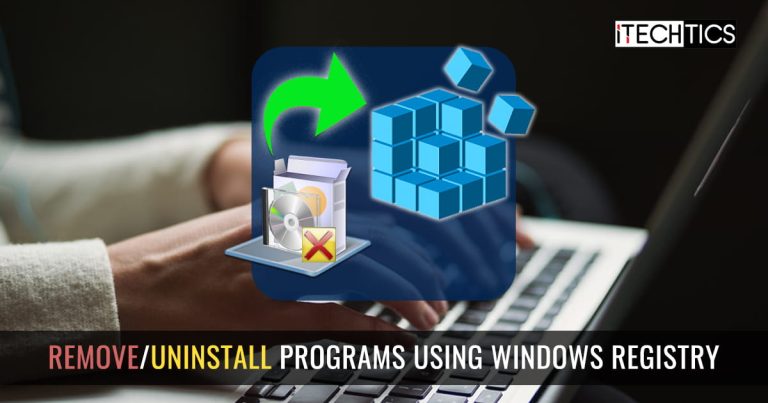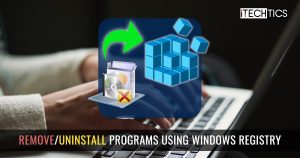If you find that unwanted programs appear on the Programs and Features page even though you have removed/uninstalled them, or if you are unable to uninstall a specific program, then the program has likely been corrupted and it cannot be removed the conventional way.
Using the Windows Registry, you can permanently uninstall programs and apps to ensure that they do not cause further problems.
Table of Contents
In some cases, you might have uninstalled a program through Add/Remove Program, but it still appears in the Control Panel (Run >> appwiz.cpl) list. If you try to run the program, it will not work either. It is best to attempt to remove it using the methods discussed in this post if that is the case.
Program location in Windows Registry
Each program has either a 32-Bit or 64-Bit architecture on your Windows computer. These categories of programs and apps are stored separately, both on the volume and within the Windows Registry.
The 32-bit applications and programs are stored in the following locations:
System Volume: C:\Program Files (x86)
Windows Registry: Computer\HKEY_LOCAL_MACHINE\SOFTWARE\WOW6432Node\Microsoft\Windows\CurrentVersion\
64-bit apps and programs are saved at the following locations:
System Volume: C:\Program Files
Windows Registry: Computer\HKEY_LOCAL_MACHINE\SOFTWARE\Microsoft\Windows\CurrentVersion\
The CurrentVersion keys further hold sub-keys for different apps and programs. One of the sub-keys is named Uninstall, which contains information pertaining to removing the program.
The values within the Uninstall key can be used to remove the entire program permanently from your computer, which is how we shall be deleting any program(s) that may be causing trouble, or are no longer required.
Uninstall Windows Registry key
Before we proceed to the uninstallation process, let us learn how to determine which key belongs to which program, since most sub-keys in the Uninstall key are not named directly with the associated program’s name.
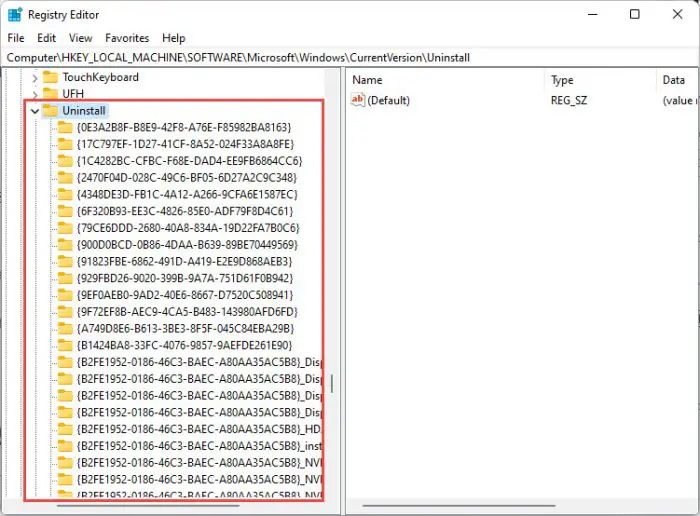
If you click on the key under Uninstall, you may find the following parameters (values) and the related information:
Note: These are common values. You may see come across some values that are not mentioned in the list below.
- DisplayName
- DisplayVersion
- Publisher
- VersionMinor
- VersionMajor
- Version
- HelpLink
- HelpTelephone
- InstallDate
- InstallLocation
- InstallSource
- URLInfoAbout
- URLUpdateInfo
- AuthorizedCDFPrefix
- Comments
- Contact
- EstimatedSize
- Language
- ModifyPath
- Readme
- QuietUninstallString
- UninstallString
- SettingsIdentifier
The only parameters you should be interested in are DisplayName, QuietUninstallString, and UninstallString.
DisplayName is the identifier that will assist you to recognize to which program the key in the Windows Registry belongs. This means that you will need to click on each key before determining which key is the one that you wish to delete.
Note: Some Windows Registries may be named (correctly) after the associated program.
The values QuietUninstallString and UninstallString will be used in the process of uninstalling the program further down the article.
We can now begin to remove the program that you want to.
Uninstall/Remove programs using Windows Registry
You can uninstall the program through the Windows Registry if you are unable to do so through the program itself, or through the Programs and Features page in the Control Panel.
However, if you simply see a program on the Programs and Features page that is no longer installed but still visible, you can delete the associated Windows Registries to remove it from the list.
Since both processes involve manipulation of the Windows Registry, it is better to create a restore point before proceeding forward, in case the system is at risk of wrongful Registry manipulation.
Completely uninstall the program using Windows Registry
Since the names of the keys in the Windows Registry are ambiguous, it is better to create a backup of the Registry, and then proceed towards the uninstallation.
Here is how to do so:
- Launch the Registry Editor by typing in regedit in Run.
- Now paste the complete location of the Uninstall key in the address bar for quick navigation:
- 32-Bit:
Computer\HKEY_LOCAL_MACHINE\SOFTWARE\WOW6432Node\Microsoft\Windows\CurrentVersion\Uninstall - 64-Bit:
Computer\HKEY_LOCAL_MACHINE\SOFTWARE\Microsoft\Windows\CurrentVersion\Uninstall
- 32-Bit:
- Now look for the key that you want to remove. Remember that you can find the name of the associated program in the DisplayName value.
- When found, right-click on the key and click Export from the context menu.
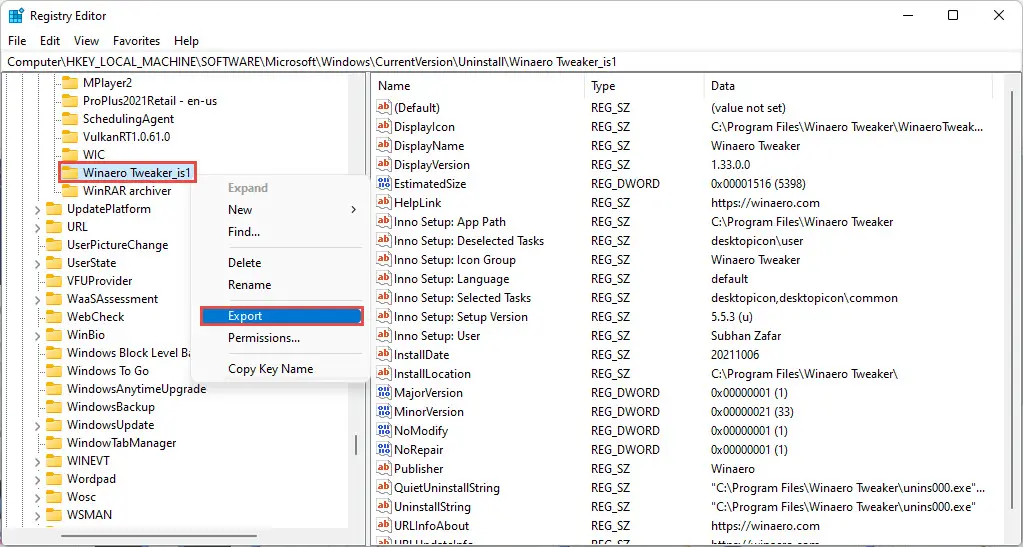
- In the pop-up window, select a location to save the backup Registry file, enter the name of your choice, and click Save.
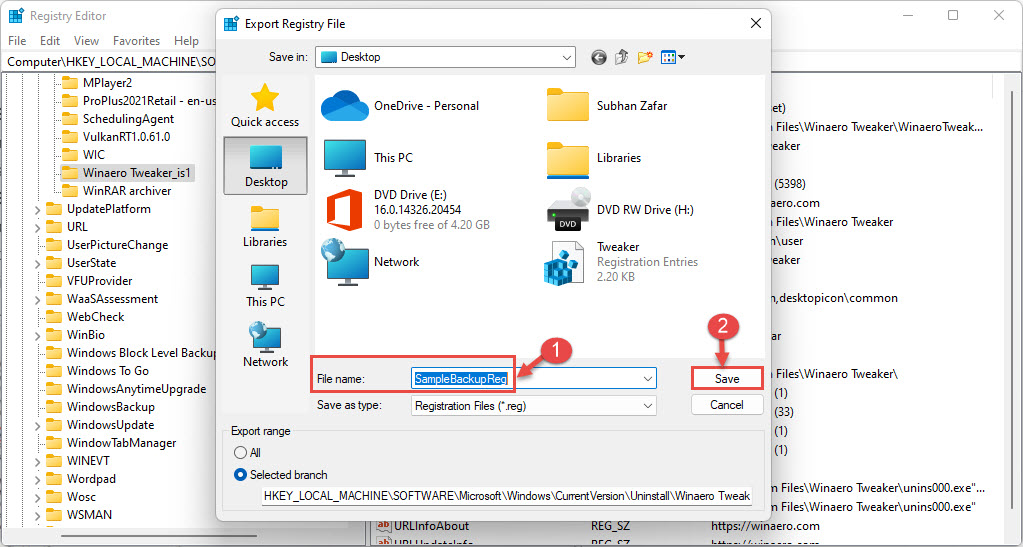
A local backup of the Windows Registry that you are about to remove has been made. - Now, click on the associated key of the program that you want to remove, and then double-click on either of the values in the right-hand pane:
- QuietUninstallString – For quietly removing the program (no prompts or confirmation)
- UninstallString – To remove the program with complete due process
- In the Edit String popup, copy the Value Data.

- Now launch the Command Prompt with administrative privileges, paste the copied content and press Enter to run it.
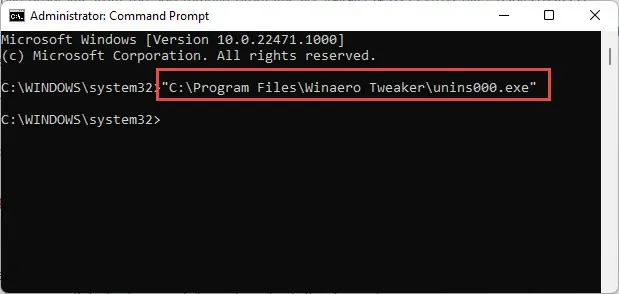
- If you selected UninstallString in step 6, then you may encounter some confirmation dialog boxes or an uninstall/reinstallation wizard. Follow through with them to remove the program.
- Now confirm if the correct program has been removed through the Programs and Features page in the Control Panel. If so, you can continue to delete the manual backup of the Registry as well. If not, you may want to restore the Registry file by double-clicking it. This will bring back the deleted Windows Registry as it was before.
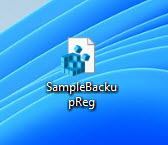
You will now have successfully removed the program and all of its Registries as well.
Remove programs using Windows Registry
Note: This process does not uninstall the program, but simply removes it from the list under the Programs and Features page in the Control Panel.
Perform the following steps to remove a program that no longer works on your Windows computer, but is still visible in the Programs and Features list.
- Open the Registry Editor by typing in regedit in Run, and then paste either of the following locations in the address bar for quick navigation:
- 32-Bit:
Computer\HKEY_LOCAL_MACHINE\SOFTWARE\WOW6432Node\Microsoft\Windows\CurrentVersion\Uninstall - 64-Bit:
Computer\HKEY_LOCAL_MACHINE\SOFTWARE\Microsoft\Windows\CurrentVersion\Uninstall
- 32-Bit:
- Now determine the key associated with the program that you wish to remove from the list by checking the DisplayName value.
- Once determined, right-click the key and then click Delete from the context menu.
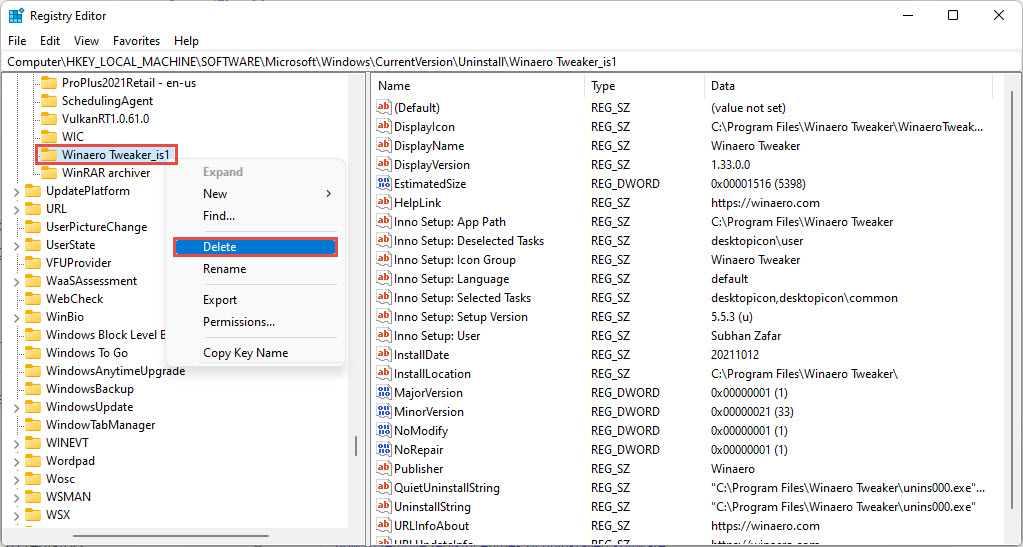
- In the confirmation dialog box, click Yes.

- You can now confirm that the program is no longer visible in the Programs and Features page (Run >> appwiz.cpl).
Verdict
You can run either the UninstallString‘s or QuiteUninstallString‘s value in the Command Prompt when you want to uninstall a program. QuietUninstallString will simply remove the program without confirming with you.
Moreover, we would advise that you adopt these methods when no other method to remove a program has worked since manually working with the Windows Registries can turn out to be deadly for your operating system.

